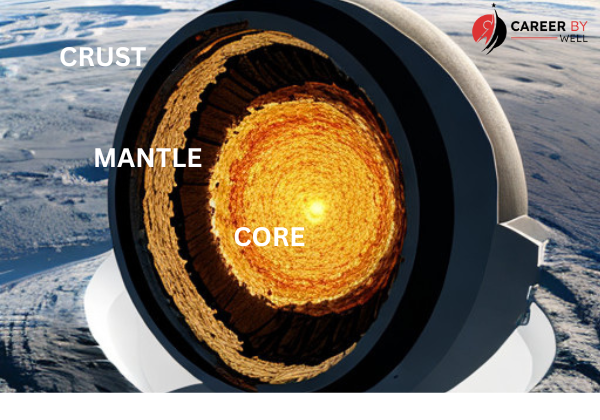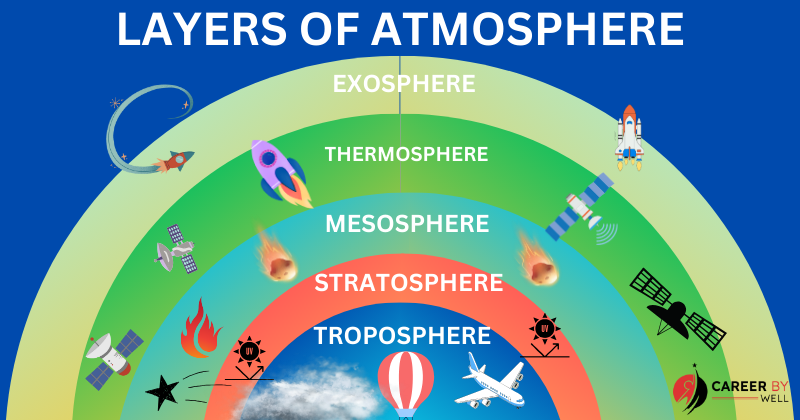The Structure of Earth consists of several distinct layers, each with its own composition and characteristics.
The Structure of the Earth consists of several distinct layers, each with its composition and characteristics. Usually, the Earth has complex structure is due to a combination of factors and processes that have operated over billions of years.
Usually, the complexity of the earth’s structure results from a combination of geological, thermal, and gravitational processes that have operated for billions of years.
This complexity is central to our understanding of Earth’s history, present state, and the dynamic processes that continue to shape our planet.
These structures of the Earth, from the innermost to the outermost, are as follows:
- Inner Core
- Outer Core
- Mantle
- Crust
Inner Core:
The inner core is the Earth’s innermost structure of the Earth and is located at the very centre of the planet. It is located at a depth of about 2,900 to 5,150 kilometres (1,800 to 3,200 miles) beneath the Earth’s surface.
It is primarily composed of iron and nickel and is extremely hot.
The intense pressure at this depth—approximately 3.7 million atmospheres—and extremely high temperatures—around 5,700 degrees Celsius cause these materials to exist in a solid state.
Even though iron and nickel are typically found in liquid form at such high temperatures.
Despite the high temperature, the inner core remains solid due to the immense pressure at this depth. However, the solid inner core generates Earth’s magnetic field.
The motion of molten iron in the outer core, driven by heat and convection currents, creates electrical currents.
These electrical currents, coupled with the Earth’s rotation, generate a magnetic field through a process known as the geodynamo effect.
This magnetic field extends into space and shields the Earth from harmful solar radiation. It is making it essential for maintaining a habitable environment.
Understanding the inner core is critical for unravelling the Earth’s internal structure and geophysical processes. It also has implications for studying the planet’s magnetic field and environmental influence.
However, direct exploration of the inner core is impossible due to its extreme depths and conditions.
Outer Core:
Surrounding the inner core is the outer core, extending from a depth of about 2,150 to 2,900 kilometres (1,340 to 1,800 miles) below the surface.
Like the inner core, the outer core primarily comprises iron and nickel. However, it is liquid due to slightly lower pressures and higher temperatures.
Usually, the movement of the molten iron in the outer core generates the Earth’s magnetic field through a process called the geodynamo.
The outer core is incredibly hot, with temperatures ranging from about 4,000 to 5,000 degrees Celsius (7,200 to 9,000 degrees Fahrenheit). The pressure within the outer core is very high due to the weight of the overlying materials.
Besides, heat from the Earth’s interior, primarily generated by the decay of radioactive isotopes, causes convection currents within the outer core.
These currents are responsible for the motion of the molten iron and nickel. The movement of these materials generates electrical currents. This, in turn, creates Earth’s magnetic field through the geodynamo effect.
Mantle:
The mantle is one of the Earth’s main compositional layers between the crust and the core. It is a critical component of the Earth’s structure and is crucial in various geophysical processes.
The mantle extends from the base of the Earth’s crust, which varies in thickness beneath continents and oceans.
The depth of the mantle is approximately 2,900 kilometres (1,800 miles) beneath the Earth’s surface. This depth marks the boundary between the mantle and the outer core.
Generally, The mantle is primarily composed of solid rock. It consists mainly of silicate minerals rich in iron and magnesium. Olivine and pyroxene are among the most abundant minerals in the mantle.
The composition of the mantle rocks is distinct from the crust, which is composed of different types of rocks. It is divided into two parts.
- The upper mantle and
- The lower mantle.
Besides, the upper and lower mantle work together to drive the movement of tectonic plates, shape the Earth’s surface, and influence geological processes such as volcanism, earthquakes, and the formation of mountain ranges.
The upper mantle is cooler and more rigid, while the lower mantle, located at greater depths, is solid but ductile and experiences higher temperatures and pressures. Both regions are essential components of the Earth’s internal dynamics.
While the mantle is primarily solid, it behaves ductile over geological time scales. This means that the rock in the mantle can flow slowly under high pressure and high-temperature conditions.
This flow is responsible for many geological processes, including the movement of tectonic plates.
Crust:
The Earth’s crust is essential to humans as it is the region where we live, build cities, extract natural resources, and cultivate agricultural land.
Understanding the composition and structure of the Earth’s crust is vital for a wide range of human activities, including construction, resource exploration, and disaster preparedness.
The Earth’s crust is the outermost layer of the planet’s structure and is the part of the Earth that we interact with directly. The Earth’s crust is thin compared to the other layers.
The structure of the Earth’s crust may be divided into two parts:
- Oceanic Crust
- Continental Crust
Structure of Oceanic Crust
While the oceanic crust underlies the ocean basins. It is composed mainly of basalt, a type of volcanic rock, and is denser than continental crust. The oceanic crust is generally thinner, with an average thickness of around 7 to 10 kilometres (4 to 6 miles).
The oceanic crust is characterized by underwater features like mid-ocean ridges, ocean trenches, and seafloor spreading zones. Mid-ocean ridges are long underwater mountain chains where new oceanic crust is formed through volcanic activity, while ocean trenches are deep-sea canyons where older oceanic crust is subducted back into the mantle.
Structure of the Continental Crust
The continental crust makes up the landmasses and continents on Earth. It primarily consists of various rocks, including granites, sedimentary rocks, and metamorphic rocks.
Continental crust is less dense than oceanic crust and typically thicker, ranging from about 20 to 70 kilometres (12 to 43 miles).
Besides, the crust comprises various rock types, including granite (continental crust) and basalt (oceanic crust). It is where we find the Earth’s solid surface, including continents, oceans, and landforms.
Final Thoughts
In short, These layers represent the Earth’s internal structure. Each layer’s characteristics and interactions play a crucial role in geological processes. For example, the movement of tectonic plates, the formation of mountains and ocean basins, and the generation of earthquakes and volcanic activity.
Lastly, the interior of the Earth has a profound and continuous influence on its surface through various geological processes. These processes, driven by the Earth’s internal heat, composition, and structure, are pivotal in shaping the planet’s surface.
In summary, the Earth’s interior, particularly the mantle and its dynamics, drives the various geological processes that shape the planet’s surface.
These processes are interconnected and have shaped the Earth’s landscape over billions of years, continually influencing its topography, geological features, and the distribution of land and water.


